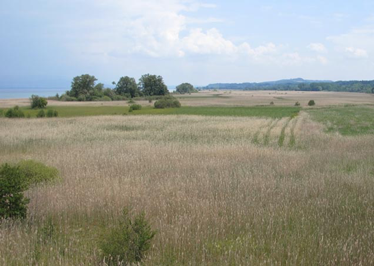Effets à long terme du fauchage des marais sur les oiseaux nicheurs
Guillaume Lavanchy, Association de la Grande Cariçaie et University of Lausanne
   |
Les marais sont parmi les habitats les plus riches, mais aussi les plus menacés sur terre. Une menace majeure est la modification des régimes hydriques pour les activités humaines, qui perturbe l'équilibre naturel des écosystèmes. Dans les marais lacustres, une réduction des crues permet aux buissons de prendre le dessus, menant à terme à une évolution du milieu vers des communautés forestières. Pour contrer cette évolution, les gestionnaires de zones humides ont mis en place différentes mesures, y compris le fauchage, le brûlis, et le pacage. Du fait de la faible échelle temporelle des études précédentes sur la question, on sait peu de choses sur les potentiels effets néfastes du fauchage à long terme.
Dans les marais de la Grande Cariçaie, situés le long de la rive Sud du lac de Neuchâtel, le niveau des eaux a commencé à être contrôlé précisément dès les années 1960, entraînant une diminution de la fréquence et de l'amplitude des crues. La plupart des marais sont es habitats non-climaciques, et dépendent de fréquentes perturbation pour leur maintien. Dans la Grande Cariçaie, le fauchage a été initié dans les années 80 pour contrer l'embuissonnement, en coupant les buissons et en exportant de la matière organique.
Durant mon service civil auprès de l'Association de la Grande Cariçaie, j'ai réalisé que Michel Antoniazza, l'ornithologue qui y travaillait, avait accumulé une quantité de données astronomiques sur le sujet. Ses recensements d'oiseaux, effectués sur une période de 30 ans dans des zones avec différents régimes de fauche, constituaient le matériel idéal pour évaluer les effets à long terme du fauchage sur les oiseaux, et plus largement sur l'écosystème. Convaincu que cette mine d'or méritait d'être exploitée, j'ai entrepris d'analyser les données et ai écrit un article à ce sujet.
Dans ce papier, nous évaluons les effets à long terme du fauchage sur les populations nicheuses des cinq espèces d'oiseaux les plus abondantes dans les réserves de la Grande Cariçaie: la rousserole effarvate (Acrocephalus scirpaceus), le bruant des roseaux (Emberiza schoeniclus), la locustelle luscinioïde (Locustella luscinioides), le râle d'eau (Rallus aquaticus), et la panure à moustache (Panurus biarmicus). Nos résultats montrent que le fauchage n'a pas d'effet néfaste sur les oiseaux sur le long terme. Par contre, le rythme de fauche optimal pour les oiseaux serait souvent moins fréquent qu'exercé habituellement. Nous recommandons que le fauchage soit espacé tous les 3 ans au moins, et idéalement tous les 6 ans ou plus. Dans le papier, nous discutons des mesures supplémentaires qui peuvent être mises sur pied pour complémenter le fauchage. Du fait de la large distribution des espèces et habitats ciblés, notre étude fournit des informations directement applicables pour les gestionnaires de zones humides en Europe et au-delà.
Plus largement, cette étude est un bon exemple que le renforcement du dialogue entre l'univers académique et le monde appliqué peut se montrer bénéfique d'un côté comme de l'autre. D'un côté, les biologistes de la conservation peuvent tirer profit des nouvelles méthodes statistiques et autres techniques de pointe que les universités peuvent fournir. Les chercheurs, quant à eux, peuvent gagner une importante connaissance naturaliste et trouver des données inespérées auprès des naturalistes travaillant dans la conservation appliquée. Ces connaissances et ces données sont précieuses pour améliorer notre compréhension des écosystèmes, et nous permettre de mieux les protéger.
L'article est publié dans Biodiversity and Conservation et est disponible librement ici: https://link.springer.com/article/10.1007/s10531-017-1462-1.
